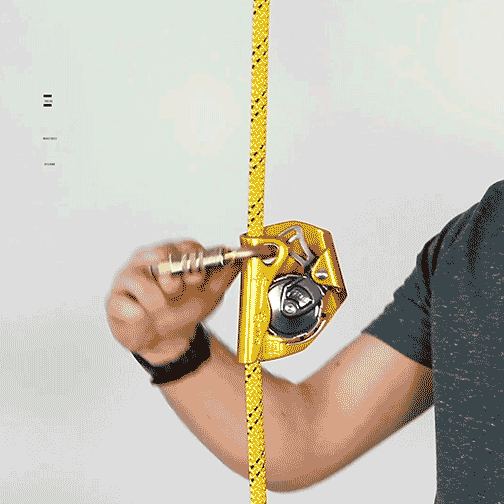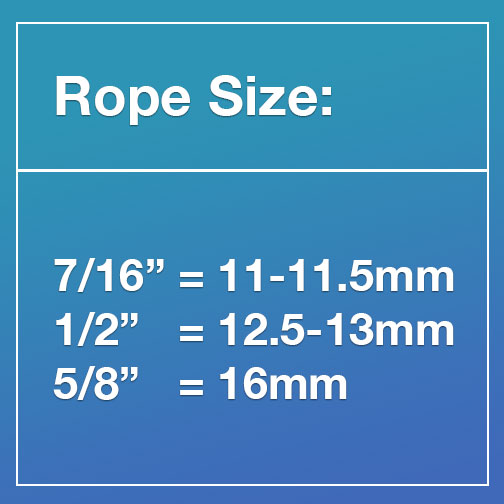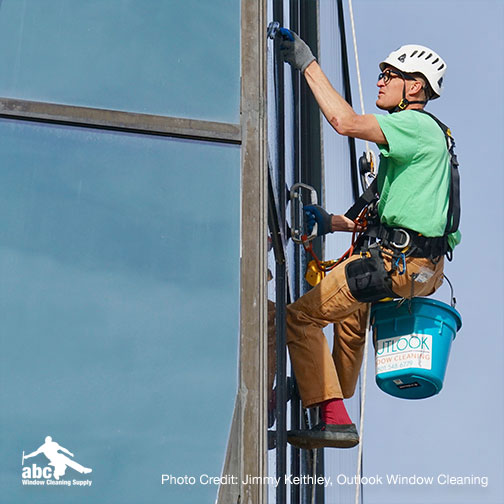Rope Grabs and Back Ups For High Rise Window Cleaning and Rope Access
DISCLAIMER
Information on this page was last updated on 4/13/2020. For the latest information, refer to manufacturer’s instructions. Any information provided by abc is intended to help you decide which gear will work for you and is not a substitute for proper training and your evaluation of specific work site conditions. Work at height is inherently dangerous. User accepts full responsibility for the use of this and any other safety equipment. ABC OFFERS NO EXPRESS WARRANTIES AND DENIES THE EXISTENCE OF ANY IMPLIED WARRANTIES. ANY WARRANTIES WITH RESPECT TO THE PRODUCTS SOLD ARE PROVIDED BY THE MANUFACTURER.
What is a Rope Grab?
A rope grab for window cleaners is any device that can lock onto a rope such as a prusik, handle ascender (which shouldn’t be used as your backup), or Petzl ASAP. Some rope grabs are used for ascending rope, some for hauling, and some as backup devices for highrise window washers. According to Tritech Fall Protection, a backup device is “A deceleration device which travels on a lifeline and automatically, by friction, engages the lifeline and locks so as to arrest the fall of an employee. A rope grab usually employs the principle of inertial locking, cam/level locking or both (also referred to as a fall arrester).” For rope descent and rope access, you must have a main line and a backup line with your fall arrester system. For working on a rooftop, you need to have either fall restraint or fall arrest of some kind (check out this resource for roof top fall protection).While prusik cords still exist, high rise window cleaners will want to use a mechanical backup device. On this page, we’ll mean backup device when referring to a rope grab unless otherwise specified. Rope grabs are also known as: • Back up devices • Fall arresters • Fall Arrest Systems • Fall arrest device • Grabs • Safeties
Shop Rope Grabs
ATTRIBUTES OF ROPE GRABS

Self-Trailing vs. Manual
When descending, a self trailing fall arrest device follows you on its own without you having to adjust the device. This offers obvious convenience and can help prevent simple rescue situations where you forget to descend without releasing your grab. It also allows you to minimize your potential fall distance with shorter lanyards, which would be extremely annoying with a manual rope grab. Not all self-trailing backup devices are created equal. Some, like the Kong Backup (a Kong rope grab) and Camp Goblin (a Camp backup device) work great but will need occasional intervention. Others, like the Petzl ASAP will operate extremely smoothly and almost never require intervention.
Manual rope grabs have to be adjusted by the user every time that you want to descend. Remember, when adjusting a manual rope grab don’t grab the device itself! In case of a fall, your panic reaction may cause you to hold the rope grab in the open position, preventing it from engaging. Carefully read the manufacturer’s instructions for proper use of your device. Manual devices are the favorite of many rope descent workers. Once in place, they won’t drift down the rope or be affected by windy conditions which can increase the fall factor in some cases with a self-trailing device. The most popular is the MIO grab with a 3’ shock absorbing lanyard.
Some devices do double duty with the option to use as a manual or self-trailing grab. These are often referred to as Locking devices because they can be put into “Up Only” mode, meaning they won’t go down the rope, even manually, but can go up the rope. The Camp Goblin and Petzl ASAP Lock, for example, have a switch which will toggle between modes. This is useful if you intend to stay in one spot for a while or if windy conditions are pulling rope through the device and increasing your potential fall factor.

Rope Size
When doing work at height of any sorts, the size of your rope will likely help determine the equipment used in your setup. It is essential that you use compatible equipment! Follow the manufacturer’s instructions for your rope and chosen devices. For window cleaners, the most common sizes of rope used are 7/16” and ½”. Other industries, like rope access, reference rope diameters in millimeters, which is why you’ll also see rope grabs that use “mm” to dictate the proper rope to be used with the specific device. Some devices will simply say that they work with ½” rope while others will list a range or rope sizes that they work with. Check what sizes the rope grab works on before purchasing to avoid potential complications. Never use a rope grab that does not fit your rope size and type.
Anti-Panic
In an emergency situation, like a fall, often the natural response is to grab the backup device itself. This can prevent the rope grab from engaging, resulting in a fall. When a rope grab is described as anti panic, that means the manufacturer says that the rope grab will still engage in an emergency, even if someone grabs for the device. There is no specific definition of what Anti-Panic means from OSHA or ANSI, so the exact meaning can vary from manufacturer to manufacturer. While a device might have anti-panic features, often manufacturers will not call devices “anti-panic”, using those exact words. Instead, they will describe a situation where someone falling grabs the device in a particular way and it still engages. And since abc uses the exact information manufacturers offer for each product, we advise you to read a rope grab’s description and the manufacturer’s instructions to see if it acts as an anti-panic device, even if those exact words are never used.

Certifications
As with your carabiners, harness, descender, and other equipment, it’s best to get rope grabs that are certified. This ensures that the equipment has been made to a high standard and makes it easier to stay compliant with OSHA.
OSHA says very little about grabs, addressing them only generally. For all fall arrest equipment OSHA requires that it limit the maximum arresting force on the employee to 1,800 pounds (1910.140(d)(1)(i)), bring the employee to a complete stop (1910.140(d)(1)(ii)), and be strong enough to withstand twice the potential force of a 6’ free fall (1910.140(d)(1)(iii)). You can see all of the details here. There is generally no OSHA stamp to be found on rope grabs, but all backup devices that abc sells meet OSHA requirements when used properly.
The most common and applicable standard is ANSI Z359. It requires that fall arresters lock automatically without any input form the user and that they require two consecutive, deliberate actions to open. It also lists requirements for the performance of the device during a fall and requirements for the lanyard that you use. While using ANSI gear isn’t required and there are a lot of great devices that aren’t ANSI, it’s easier to justify your equipment decisions to OSHA when you use ANSI rated gear.
SPRAT Safe Practices For Rope Access Work is another common guide used in the rope access industry covering both equipment and technique. It’s a great best practices guide though it is unlikely to be referenced by OSHA during an inspection. Window washers commonly use Rope Descent or RDS, meaning they simply descend down a rope. Rope Access includes RDS skills but also covers a variety of other rope skills for rescues, going up a rope, and more. Safe Practices says a Backup Device should be intended for rope access use and be suitable for use in rescue (13.4). You can see the full details here.
The IWCA also has its I-14 standard which is window cleaning specific. On rope grabs, it says that “In addition to complying with ANSI Z359.1, rope grabs used for fall arrest shall include by design, an anti panic stop feature.” (9.2.2(b)).
Standards can be complex and it can be difficult to know which ones you should work to comply with. For additional guidance, contact your local OSHA representative or a qualified trainer.
Shop Rope GrabsThe Importance of Regular Maintenance and Inspection of Rope Grabs for Window Cleaners
Regular inspection and maintenance of your rope grab for window cleaners are crucial to ensure the safety and efficiency of your high-rise window cleaning operations. Over time, rope grabs can experience wear and tear due to constant use and exposure to various environmental conditions. Regular inspection helps identify any potential issues early, preventing equipment failure that could lead to accidents.
Maintenance, on the other hand, extends the lifespan of your rope grab. This includes cleaning the device, checking for any signs of damage, and ensuring that all parts are functioning correctly. Remember, a well-maintained rope grab not only ensures safety but also improves work efficiency.
The Evolution of Rope Grabs for Window Cleaners
The rope grab for window cleaners has evolved significantly over the years, with advancements in technology and safety regulations driving these changes. Early versions of rope grabs were manual and required constant adjustment by the user. However, modern rope grabs are self-trailing, meaning they follow the user automatically during descent, reducing the risk of user error and increasing productivity.
Moreover, today's rope grabs come with anti-panic features, which ensure the device will still engage during an emergency, even if the user instinctively grabs the device. This evolution in design and functionality has made rope grabs an indispensable tool in the high-rise window cleaning industry, providing enhanced safety and efficiency for window cleaners.
FAQ & Tips From Experts
What does the rope grab connect to?
What’s the difference between a rope grab and a SRL?
Can I use my Jumar as a backup?
What lanyard should I use?
"The days of using an ascender as your backup have gone the way of answering machines, outdated and obsolete. Not to mention, who wants to see a core shot when you have just lost your main line and are hanging on your harness?! Rope grabs don’t damage the rope when activated. When paired with an appropriate shock absorber injuries will be avoided."
Biography: 30 years of on-rope experience cleaning windows.
-JIMMY KEITHLEY of Outlook Window Cleaning
"Like all safety products, inspect prior to use, user must read and understand manufacturer instructions and be fully trained on the safe use of the equipment used.
A rope grab is a vital piece of a fall arrest system for high rise window cleaners. Knowing your need and rope size will assist with choosing a compatible rope grab that works with your other components for increased safety and productivity.
Since introducing the use of a self-braking descender we also found the ease of use in a self-trailing rope grab to complete our system to increase productivity and reduce user error.
Self-trailing rope grabs provide fall protection when ascending or descending a vertical lifeline and are used as part of a complete fall arrest system (anchor, lifeline, rope grab, lanyard and full body harness) be sure all components are compatible to ensure each piece performs as designed.
Things to consider when selecting a rope grab:
• Rope size and style- Choose a compatible rope grab
• Harness Connection point- Front or Dorsal
• Manual or self-trailing rope grab
• What is the intended use
I enjoy the convenience of a self-trailing rope grab, reduces user error and increases productivity.
I avoid manual rope grabs or those with large triggers because they are easy to grab, they aren’t designed to be handled this way. I’ve witnessed the unforeseen occur, where the user froze, squeezing the unit unintentionally allowing a free fall. User error is likely when manufacturer instructions are not followed.
Our policy is for all workers to utilize the same style of devices. In an assisted rescue situation all workers know exactly how the rescued persons equipment operates which speeds in a rescue situation.
Biography: Jeff Hansen, Window Warriors Forum, business owner 22 years, working as a high rise window cleaner 27 years."
-JEFF HANSEN of Window Warriors Forum
Shop Rope Grabs
DISCLAIMER
Information on this page was last updated on 4/13/2020. For the latest information, refer to manufacturer’s instructions. Any information provided by abc is intended to help you decide which gear will work for you and is not a substitute for proper training and your evaluation of specific work site conditions. Work at height is inherently dangerous. User accepts full responsibility for the use of this and any other safety equipment. ABC OFFERS NO EXPRESS WARRANTIES AND DENIES THE EXISTENCE OF ANY IMPLIED WARRANTIES. ANY WARRANTIES WITH RESPECT TO THE PRODUCTS SOLD ARE PROVIDED BY THE MANUFACTURER.
